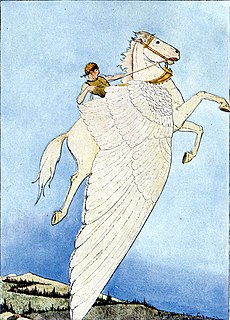
Pegasus is a famous pterippus, a mythical winged divine stallion who is one of the most recognized creatures in Greek mythology. Although often misused in popular culture, the term "Pegasus" is a proper noun, referring to a particular character, whereas the term "pterippus" is the generic name for the species of winged horses. Pegasus is usually depicted as pure white in color. Pegasus is a child of the Olympian god Poseidon. He was foaled by the Gorgon Medusa upon her death, when the hero Perseus decapitated her. Pegasus is the brother of Chrysaor and the uncle of Geryon.

The Arctic Archipelago, also known as the Canadian Arctic Archipelago, is a group of islands north of the Canadian mainland.

In Greek mythology, a Gorgon is a mythical creature portrayed in ancient Greek literature. While descriptions of Gorgons vary across Greek literature and occur in the earliest examples of Greek literature, the term commonly refers to any of three sisters who had hair made of living, venomous snakes, as well as a horrifying visage that turned those who beheld her to stone. Traditionally, while two of the Gorgons were immortal, Stheno and Euryale, their sister Medusa was not and she was slain by the demigod and hero Perseus.
Dictys was a name attributed to four men in Greek mythology.

In Greek mythology, Perseus is the legendary founder of Mycenae and of the Perseid dynasty. He beheaded the Gorgon Medusa for Polydectes and saved Andromeda from the sea monster Cetus. He was the son of Zeus and the mortal Danaë, as well as the half-brother and great-grandfather of Heracles.

The Queen Elizabeth Range is a rugged mountain range of the Transantarctic Mountains System, located in the Ross Dependency region of Antarctica.
The Lazarev Mountains are a chain of mountains in Antarctica. They extend along the west side of Matusevich Glacier southward of Eld Peak, and are about 25 nautical miles (50 km) long. The mountains were photographed from the air by U.S. Navy Operation Highjump (1946–47), the Soviet Antarctic Expedition (1957–58) and an Australian National Antarctic Research Expedition (1959). They were named by the Soviet expedition after Lieutenant Mikhail Petrovich Lazarev, commander of the sloop Mirnyy of the Bellingshausen expedition (1819–21).

Astro Glacier is a glacier in Antarctica, between the Turner Hills and Tricorn Peak in the Miller Range, flowing northeast into the Marsh Glacier. It was seen by the northern party of the New Zealand Geological Survey Antarctic Expedition (1961–62) and so named because an astronomical station was set up on the bluff at the mouth of the glacier in December 1961.

Agaps is a village in the Tartar Rayon of Azerbaijan.
Nibelungen Valley is an ice free valley just west of Plane Table and Panorama Peak in the Asgard Range, Victoria Land. Nibelungen is one in a group of mythological names in the range given by New Zealand Antarctic Place-Names Committee (NZ-APC).
Eld Peak is a prominent peak, 800 metres (2,600 ft) high, rising 6 nautical miles (11 km) southeast of Reynolds Peak on the west side of Matusevich Glacier in Antarctica. Two conical peaks were sighted in the area from the Peacock on January 16, 1840 by Passed Midshipmen Henry Eld and William Reynolds of the United States Exploring Expedition (USEE) (1838–42). The southeastern peak was named for Eld by USEE leader Lieutenant Charles Wilkes.
Elder Peak is a peak at the north margin of Chapman Snowfield in the Churchill Mountains of Antarctica. The peak rises to 2,360 metres (7,740 ft) 6 nautical miles (11 km) southwest of Mount Wharton. It was named after William C. Elder, a United States Geological Survey topographic engineer with the Topo North – Topo South survey expedition in these mountains, 1961–62.
Elephant Moraine is an isolated moraine, 3 nautical miles (6 km) long, located 27 nautical miles (50 km) west of Reckling Peak, to the west of the head of Mawson Glacier in Victoria Land, Antarctica. The moraine, described in some reports as an ice core moraine, is situated along a long, narrow patch of bare ice that extends west from Reckling Peak for 60 nautical miles (110 km). The feature was noted in U.S. satellite imagery of 1973, and in aerial photographs obtained subsequently, by William R. MacDonald of the United States Geological Survey, who originally described it to William A. Cassidy as "a possible nunatak having an outline similar to an elephant." Several United States Antarctic Research Program field parties led by Cassidy successfully searched for meteorites at this moraine from the 1979–80 southern summer season. The descriptive name was approved by the Advisory Committee on Antarctic Names in 1989.
Gorgons Head is a peak southeast of Mount Hughes in the Cook Mountains of Antarctica. The peak is sandstone with dolerite intrusions and is a sharp summit ridge. It was named after the Gorgons, three winged creatures of Greek mythology only one of which (Medusa) could be killed by having its head cut off.
Hessler Peak is a sharp peak, 1,670 metres (5,480 ft) high, at the south end of Dunbar Ridge in the Heritage Range in Antarctica. It was mapped by the United States Geological Survey from surveys and U.S. Navy air photos from 1961–66, and was named by the Advisory Committee on Antarctic Names for Victor P. Hessler, an ionosphere physicist and United States Antarctic Research Program scientist at the Soviet Vostok Station in the 1965–66 and 1966–67 summer seasons.
Ronald Ridge is a narrow ridge, 5 nautical miles (9 km) long, located 1 nautical mile (1.9 km) west of Donald Ridge, which it resembles, in the Pioneer Heights, Heritage Range, Antarctica.
Little Murray River, a perennial stream of the Clarence River catchment, is located in the Northern Tablelands district of New South Wales, Australia.

![]()







